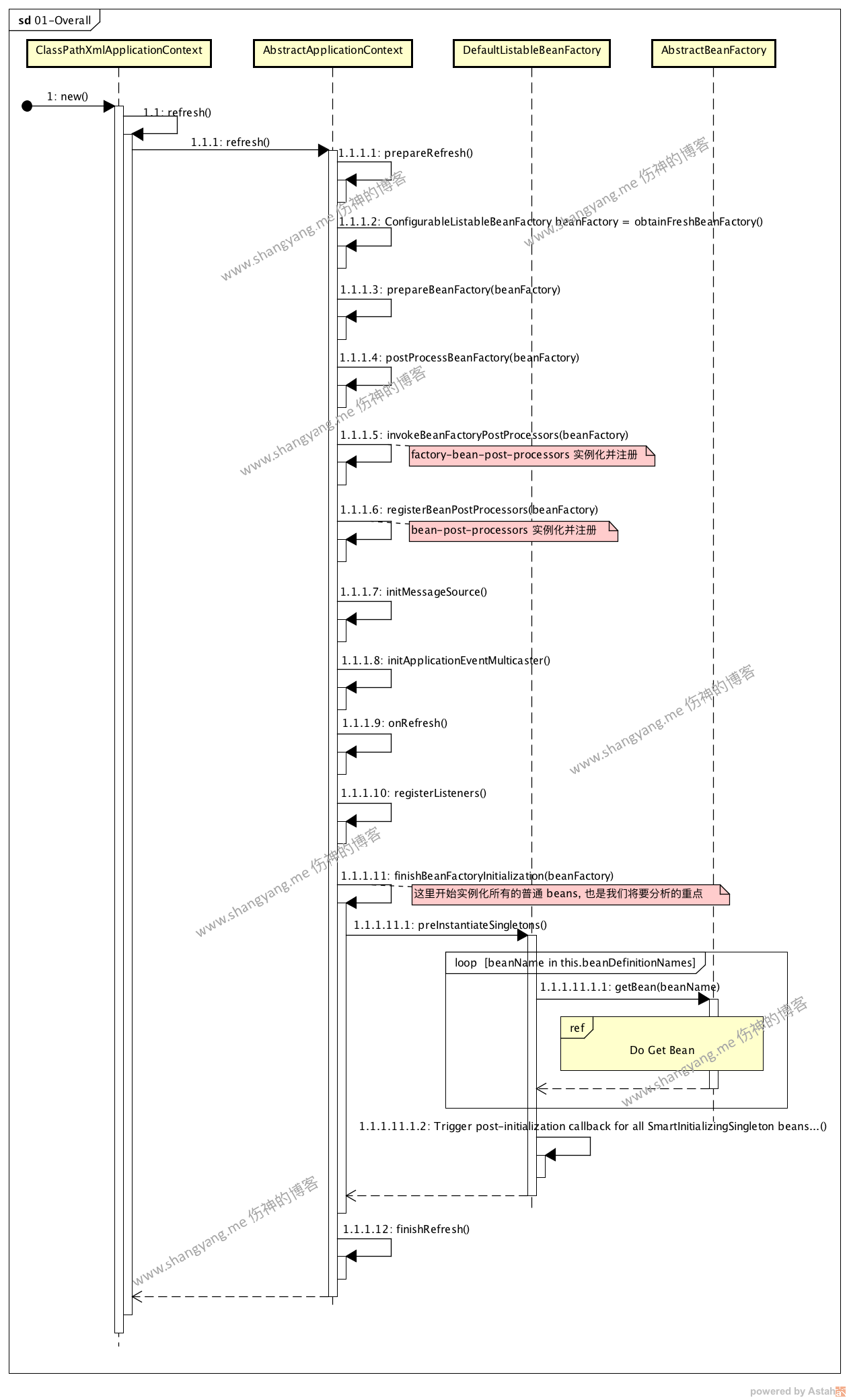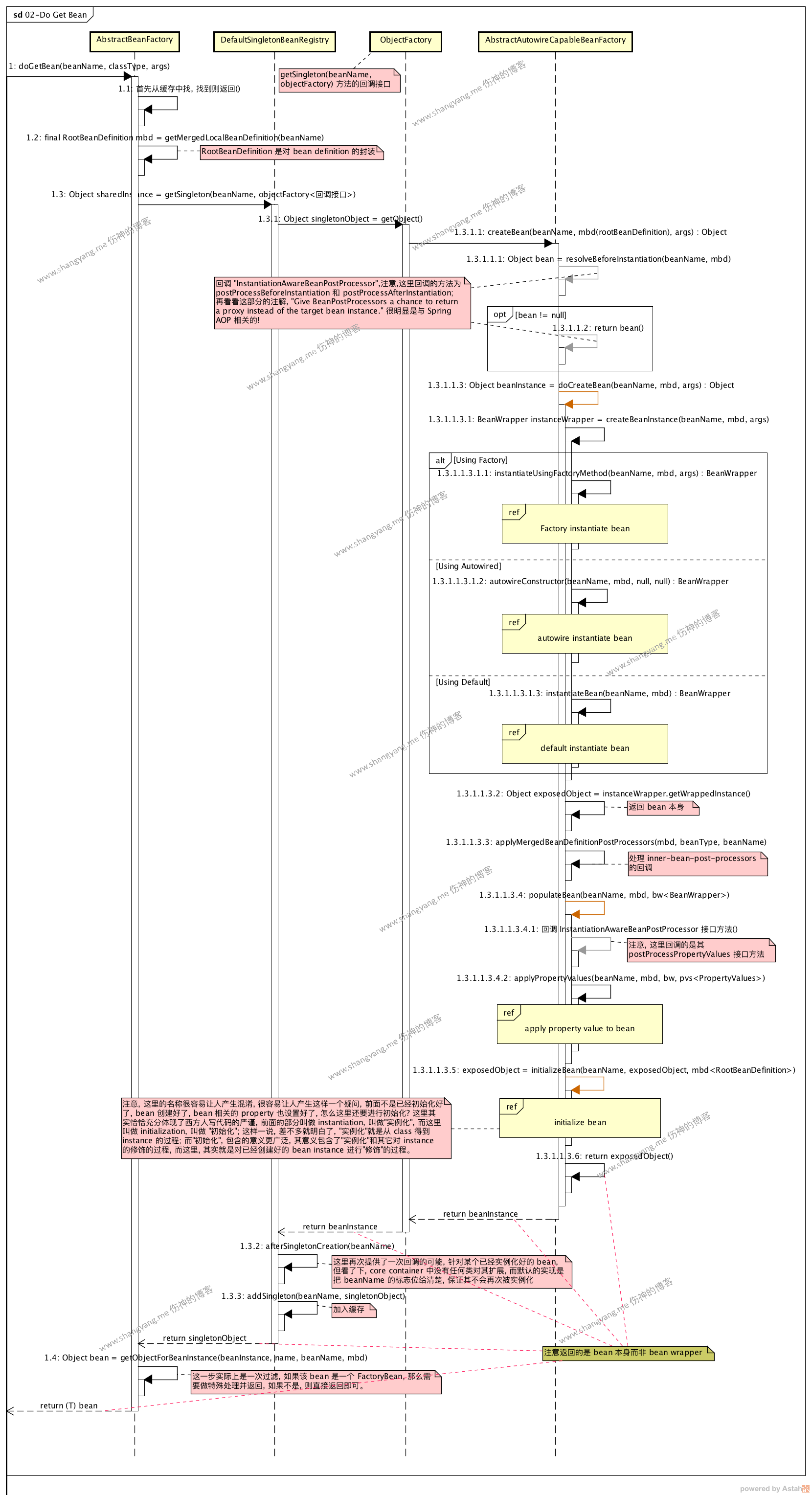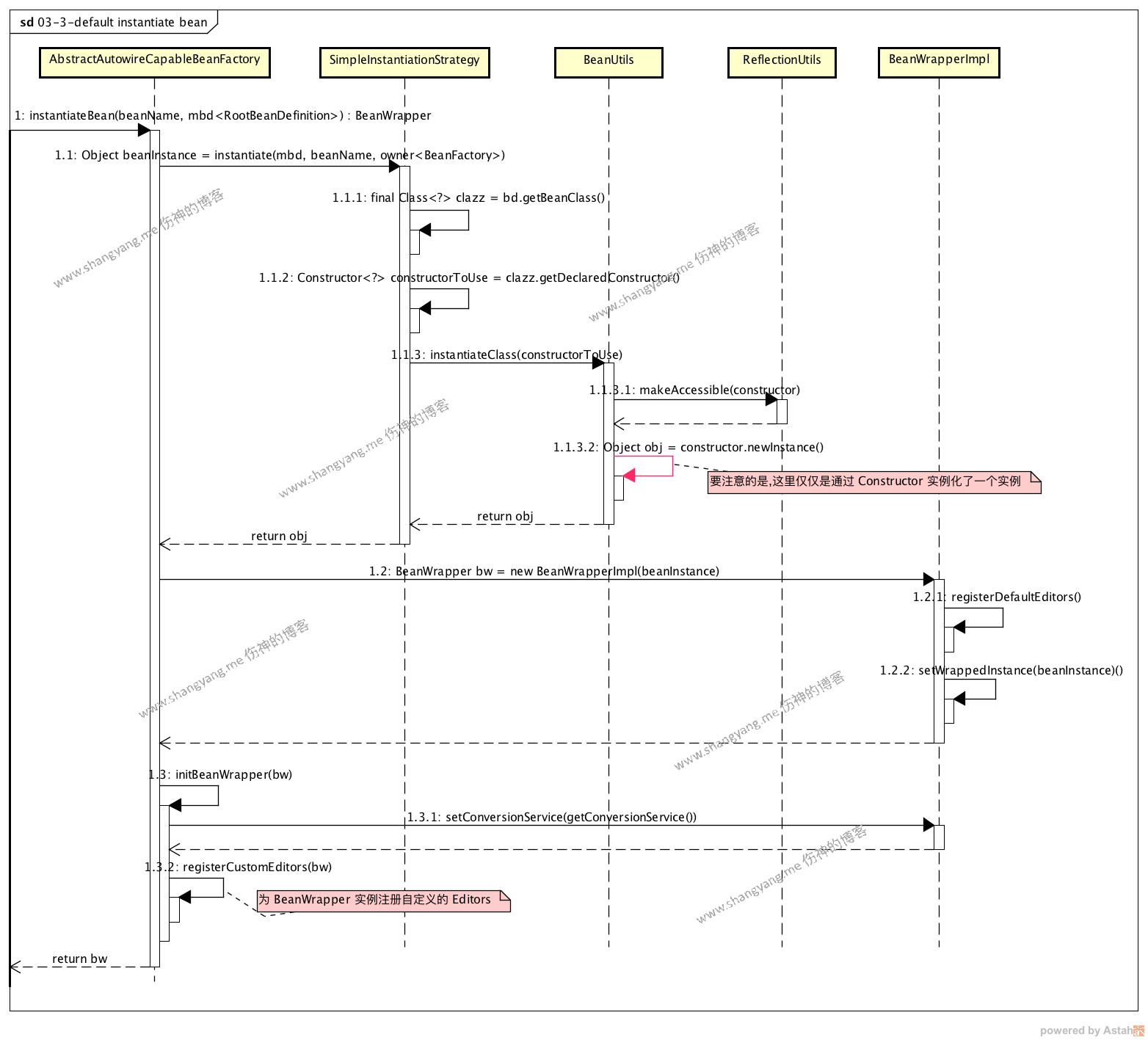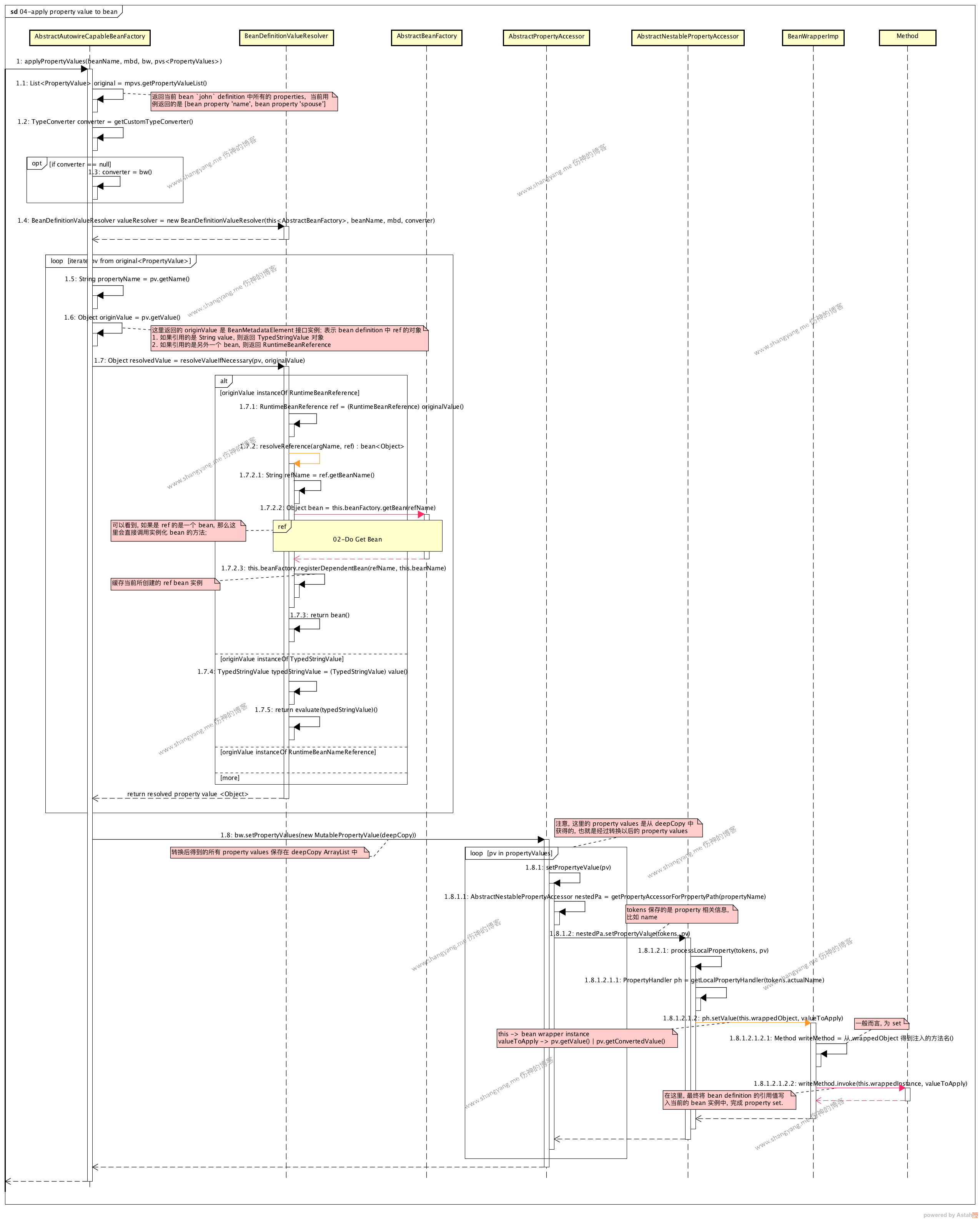前言
本文是笔者所著的 Spring Core Container 源码分析系列之一;
本篇文章主要试图梳理出 Spring Beans 的初始化主流程和相关核心代码逻辑;
本文为作者的原创作品,转载需注明出处;
源码分析环境搭建
参考 Spring Core Container 源码分析二:环境准备
测试用例
依然使用这个官网上的用例,来进行调试;
Person.java1
2
3
4
5
6
7
8
9
10
11
12
13
14
15
16
17
18
19
20
21
22
23
24
25
26
27
28
29
30
31package org.shangyang.spring.container;
/**
-
- @author shangyang
*
*/
public class Person {
String name;
Person spouse;
public String getName() {
return name;
}
public void setName(String name) {
this.name = name;
}
public Person getSpouse() {
return spouse;
}
public void setSpouse(Person spouse) {
this.spouse = spouse;
}
}
beans.xml1
2
3
4
5
6
7
8
9
10
11
12
13
14
15
16<beans xmlns="http://www.springframework.org/schema/beans"
xmlns:xsi="http://www.w3.org/2001/XMLSchema-instance"
xmlns:p="http://www.springframework.org/schema/p"
xsi:schemaLocation="http://www.springframework.org/schema/beans
http://www.springframework.org/schema/beans/spring-beans.xsd">
<!-- 传统的方式 -->
<bean name="john" class="org.shangyang.spring.container.Person">
<property name="name" value="John Doe"/>
<property name="spouse" ref="jane"/>
</bean>
<bean name="jane" class="org.shangyang.spring.container.Person">
<property name="name" value="Jane Doe"/>
</bean>
</beans>
1 |
|
源码分析
备注,这里只针对 Spring 容器实例化 singleton bean 的主流程进行介绍;singleton bean 在 Spring 容器中被初始化的特点是,在 Spring 容器的启动过程中就进行初始化;
(最好的分析源码的方式,就是通过高屋建瓴,逐个击破的方式;首先通过流程图获得它的蓝图(顶层设计图),然后再根据蓝图上的点逐个击破;最后才能达到融会贯通,胸有成竹的境界;所以,这里作者用这样的方式带你深入剖析 Spring 容器里面的核心点,以及相关主流程到底是如何运作的。)
主流程

本章节我们将详细去阐述的是,Spring 容器是如何对 Singleton bean 进行初始化并注册到当前容器的;与之相关的主要有两个流程,
解析 bean definitions 并注册
解析 bean definitiions 并注册到当前的 BeanFactory 中;此步骤是在 step 1.1.1.2 obtainFreshBeanFactory 完成;更详细的介绍参考解析并注册 bean definitions 流程从 #1 中找到所有的已注册的 singleton bean definitions,遍历,实例化得到 Singleton beans;此步骤对应的是 step 1.1.1.11 finishBeanFactoryInitialization 开始进行 singleton bean 的构造过程,其后调用
AbstractBeanFactory#getBean(beanFactory)方法进行构造;更详细的介绍参考 Do Get Bean 流程。
解析并注册 bean definitions 流程
该部分参考新的博文 Spring Core Container 源码分析七:注册 Bean Definitions
Do Get Bean 流程
Do Get Bean 流程的入口是 AbstractBeanFactory#doGetBean 方法,主流程图如下,

主流程大致为,从缓存中找到是否已经实例化了该 singleton bean,如果已经实例化好了,那么就直接返回;如果在缓存中没有找到,则将当前的 bean 封装为 RootBeanDefinition,然后通过调用 DefaultSingletonBeanRegistry#getSingleton 得到初始化好的 singleton bean,然后将其注册至缓存( step 1.3.3 addSingleton ),然后再判断是普通 bean 还是 factory bean 作必要的处理( step 1.4 getObjectForBeanInstance )后,最后返回;
RootBeanDefinition
初始化了一个 RootBeanDefinition 对象,正如其类名描述的那样,是该 bean 的顶层描述;包含了 bean 的字段属性,ref属性以及继承相关等等属性;
Step 1.3:DefaultSingletonBeanRegistry#getSingleton
此步骤的相关代码如下,1
2
3
4
5
6
7
8
9
10
11
12
13
14
15
16
17
18
19// Create bean instance.
if (mbd.isSingleton()) {
sharedInstance = getSingleton(beanName, new ObjectFactory<Object>() {
public Object getObject() throws BeansException {
try {
return createBean(beanName, mbd, args);
}
catch (BeansException ex) {
// Explicitly remove instance from singleton cache: It might have been put there
// eagerly by the creation process, to allow for circular reference resolution.
// Also remove any beans that received a temporary reference to the bean.
destroySingleton(beanName);
throw ex;
}
}
});
bean = getObjectForBeanInstance(sharedInstance, name, beanName, mbd);
}
调用父类 DefaultSingletonBeanRegistry#getSingleton 方法;注意,这里通过接口 ObjectFactory<Object> 定义了一个回调方法 getObject(),通过该回调方法调用 AbstractAutowireCapableBeanFactory#createBean 方法,通过此回调方法正式拉开了实例化 bean 的序幕。
Step 1.3.1.1:AbstractAutowireCapableBeanFactory#createBean
AbstractAutowireCapableBeanFactory#doCreateBean 方法是初始化 bean 的最核心的入口方法,执行流程如 Do Get Bean 流程所示,
主流程主要做了这么三件事情,一、instantiate bean;二、populate bean;三、initialize bean;
包含五个子流程,他们分别是 factory instantiate bean、autwire instantiate bean、default instantiate bean、populate bean 以及 initialize bean,其中,前三个子流程对应第一件事情,实例化 bean;其次的子流程 populate bean 对应的是第二件事情,为 bean 设置 property 参数;最后一个子流程 [initialize bean] 对应最后一件事情既初始化 bean,这里的初始化指的是是对创建好的 bean 做一些修饰动作的。
下面我们分别来分析这三件事情
第一件事情:instantiate bean
该步骤对应 Do Get Bean 流程中的 Step 1.3.1.1.3.1 createBeanInstance;根据 bean 的不同配置方式,实现了三种实例化 bean 的方式,分别是 factory instantiate bean、autwire instantiate bean 以及 default instantiate bean;
factory instantiate bean
用工厂方法实例化 bean,待叙;
autwire instantiate bean
通过 autowire 注解的方式实例化 bean,待叙;
default instantiate bean
此步骤对应 Do Get Bean 流程中的 Step 1.3.1.1.3.1.3 instantiateBean,其对应子流程 default instantiate bean 如下图所示,

注意几点
- 这里仅仅是通过使用其构造函数 constructor 使用
Java 反射实例化了 bean,并没有对其进行任何的参数赋值,赋值过程参考 populate bean 流程; - 将 bean 封装为 BeanWrapper,然后
- 注册 default PropertyEditor
- 注册 custom PropertyEditor
最后返回 BeanWrapper
第二件事情:populate bean
对应 Do Get Bean 流程中的 Step 1.3.1.1.3.4 populateBean,通过调用 AbstractAutowireCapableBeanFactory#populateBean 正式给 bean 的参数进行赋值;为什么方法名取名为populate呢?查百度翻译,结果是居住于、生活于、移民于、落户于的意思,丝毫没有赋值的意思,但是记得以前和美国人共事的时候,他们非常喜欢用这个词populate,特别是在创建某个对象的时候,他们特别喜欢用这个词;后来无意中发现,populate有创建和填充的意思,所以,这里的意思就是,填充这个 bean;下面看看 populate bean 的流程图,看看它是怎么玩的,

通过调用 AbstractAutowireCapableBeanFactory#applyPropertyValues 方法正式给 bean 进行赋值操作,赋值的主流程主要包括两个部分,resolve property value object 和 set property value to bean
resolve property value
对应上面 Sequence Diagram 中的 Step 1.5 - Step 1.7;这一步主要是去遍历当前 bean 所有的 property,并依次解析(resolve)得到对应的 Java 对象;通过方法 BeanDefinitionValueResolver#resolveValueIfNecessary 进行解析,解析的过程是针对不同类型的 Property,采用不同的解析方式,里面目前总共对应了十种类型,先看看它的源码,1
2
3
4
5
6
7
8
9
10
11
12
13
14
15
16
17
18
19
20
21
22
23
24
25
26
27
28
29
30
31
32
33
34
35
36
37
38
39
40
41
42
43
44
45
46
47
48
49
50
51
52
53
54
55
56
57
58
59
60
61
62
63
64
65
66
67
68
69
70
71
72
73
74
75
76
77
78
79
80
81
82
83
84
85
86
87
88
89
90
91
92
93
94
95
96
97
98
99
100
101
102
103
104public Object resolveValueIfNecessary(Object argName, Object value) {
// We must check each value to see whether it requires a runtime reference
// to another bean to be resolved.
if (value instanceof RuntimeBeanReference) { // 这里表示该 bean definition ref 引用的是一个 bean,那么这里,必须对该 bean 进行初始化操作;
RuntimeBeanReference ref = (RuntimeBeanReference) value;
return resolveReference(argName, ref);
}
else if (value instanceof RuntimeBeanNameReference) {
String refName = ((RuntimeBeanNameReference) value).getBeanName();
refName = String.valueOf(doEvaluate(refName));
if (!this.beanFactory.containsBean(refName)) {
throw new BeanDefinitionStoreException(
"Invalid bean name '" + refName + "' in bean reference for " + argName);
}
return refName;
}
else if (value instanceof BeanDefinitionHolder) {
// Resolve BeanDefinitionHolder: contains BeanDefinition with name and aliases.
BeanDefinitionHolder bdHolder = (BeanDefinitionHolder) value;
return resolveInnerBean(argName, bdHolder.getBeanName(), bdHolder.getBeanDefinition());
}
else if (value instanceof BeanDefinition) {
// Resolve plain BeanDefinition, without contained name: use dummy name.
BeanDefinition bd = (BeanDefinition) value;
String innerBeanName = "(inner bean)" + BeanFactoryUtils.GENERATED_BEAN_NAME_SEPARATOR +
ObjectUtils.getIdentityHexString(bd);
return resolveInnerBean(argName, innerBeanName, bd);
}
else if (value instanceof ManagedArray) {
// May need to resolve contained runtime references.
ManagedArray array = (ManagedArray) value;
Class<?> elementType = array.resolvedElementType;
if (elementType == null) {
String elementTypeName = array.getElementTypeName();
if (StringUtils.hasText(elementTypeName)) {
try {
elementType = ClassUtils.forName(elementTypeName, this.beanFactory.getBeanClassLoader());
array.resolvedElementType = elementType;
}
catch (Throwable ex) {
// Improve the message by showing the context.
throw new BeanCreationException(
this.beanDefinition.getResourceDescription(), this.beanName,
"Error resolving array type for " + argName, ex);
}
}
else {
elementType = Object.class;
}
}
return resolveManagedArray(argName, (List<?>) value, elementType);
}
else if (value instanceof ManagedList) {
// May need to resolve contained runtime references.
return resolveManagedList(argName, (List<?>) value);
}
else if (value instanceof ManagedSet) {
// May need to resolve contained runtime references.
return resolveManagedSet(argName, (Set<?>) value);
}
else if (value instanceof ManagedMap) {
// May need to resolve contained runtime references.
return resolveManagedMap(argName, (Map<?, ?>) value);
}
else if (value instanceof ManagedProperties) {
Properties original = (Properties) value;
Properties copy = new Properties();
for (Map.Entry<Object, Object> propEntry : original.entrySet()) {
Object propKey = propEntry.getKey();
Object propValue = propEntry.getValue();
if (propKey instanceof TypedStringValue) {
propKey = evaluate((TypedStringValue) propKey);
}
if (propValue instanceof TypedStringValue) {
propValue = evaluate((TypedStringValue) propValue);
}
copy.put(propKey, propValue);
}
return copy;
}
else if (value instanceof TypedStringValue) {
// Convert value to target type here.
TypedStringValue typedStringValue = (TypedStringValue) value;
Object valueObject = evaluate(typedStringValue);
try {
Class<?> resolvedTargetType = resolveTargetType(typedStringValue);
if (resolvedTargetType != null) {
return this.typeConverter.convertIfNecessary(valueObject, resolvedTargetType);
}
else {
return valueObject;
}
}
catch (Throwable ex) {
// Improve the message by showing the context.
throw new BeanCreationException(
this.beanDefinition.getResourceDescription(), this.beanName,
"Error converting typed String value for " + argName, ex);
}
}
else {
return evaluate(value);
}
}
这里主要关注两类解析,
RuntimeBeanReference 类型解析
对应需要被解析的配置为john的 property spouse,它所对应的值是另一个 bean jane;既是一个去解析一个ref bean。
1 | <property name="spouse" ref="jane"/> |
所以可以看到,源码中是通过 resolveReference 方法调用 AbstractBeanFactory#getBean 方法去实例化一个 bean jane 并返回;对应的源码如下,
BeanDefinitionValueResolver#resolveReference
1 | /** |
通过调用this.beanFactory.getBean(refName)再次进入Do Get Bean 流程初始化得到该 ref bean;
最后,将解析出来的 Property value 放在一个deepCopy的 ArrayList 列表对象中;顾名思义,就是对值进行了一次深度的拷贝,然后将其作为 bean 的参数,随后开始进行赋值操作);
TypedStringValue 类型解析
这里主要被解析的 Property value 的类型配置为1
<property name="name" value="John Doe"/>
其 Property value 的值在配置文件中就是一个纯的字符串类型;但从源码中可以知道,Property value 是可以包含 value type 的,所以,在解析 TypedStringValue 的时候,需要根据 value type 进行解析;具体逻辑参考resolveTargetType(typedStringValue);方法。
set property value to bean
此步骤的主流程主要是通过Java Method 反射将解析出来的值赋值给当前的 bean;对应时序图中的 Step 1.8 setPropertyValues
可以看到,通过遍历 deepCopy ArrayList 对象中已经解析过后的 PropertyValue,最终由 BeanWrapperImpl 对象通过方法的反射,将值注入给当前的 bean,Step 1.8.1.2.1.2.2 writeMethod.invoke
BeanWrapperImpl.java 省略了大部分无关紧要的代码,1
2
3
4
5
6
7
8
9
10
11
12
13
14
15
16
17
18
19
20
21
22
23
24
25
26
public void setValue(final Object object, Object valueToApply) throws Exception{
final Method writeMethod = (this.pd instanceof GenericTypeAwarePropertyDescriptor ?
((GenericTypeAwarePropertyDescriptor) this.pd).getWriteMethodForActualAccess() :
this.pd.getWriteMethod());
if (!Modifier.isPublic(writeMethod.getDeclaringClass().getModifiers()) && !writeMethod.isAccessible()) {
if (System.getSecurityManager() != null) {
AccessController.doPrivileged(new PrivilegedAction<Object>() {
public Object run() {
writeMethod.setAccessible(true);
return null;
}
});
}
else {
writeMethod.setAccessible(true);
}
}
....
writeMethod.invoke(getWrappedInstance(), valueToApply);
....
}
通过这一步,将相关的 property populate 给 bean 以后,才算 bean 的实例化完成;
第三件事情:initialize bean
正如流程图中所描述的那样,这个步骤的名字非常然人迷惑,我将流程图中写的备注摘录如下,
“注意, 这里的名称很容易让人产生混淆, 很容易让人产生这样一个疑问, 前面不是已经初始化好了, bean 创建好了, bean 相关的 property 也设置好了, 怎么这里还要进行初始化? 这里其实恰恰充分体现了西方人写代码的严谨, 前面的部分叫做 instantiation, 叫做”实例化”, 而这里叫做 initialization, 叫做 “初始化”; 这样一说, 差不多就明白了, “实例化”就是从 class 得到 instance 的过程; 而”初始化”, 包含的意义更广泛, 其意义包含了”实例化”和其它对 instance 的修饰的过程, 而这里, 其实就是对已经创建好的 bean instance 进行”修饰”的过程。”
所以,这里的 initialize 其实就是对通过 instantiate bean 和 populate bean 两个步骤实例化好的 bean 进行后续必要的修饰;我们通过流程图来看看,它是怎么去修饰的,
通过 AbstractAutowireCapableBeanFactory#initializeBean 方法进行对 bean 的修饰过程,看源码,(删除了大部分不相关的代码)
AbstractAutowireCapableBeanFactory.java1
2
3
4
5
6
7
8
9
10
11
12
13
14
15
16
17
18
19
20
21
22
23
24
25
26
27protected Object initializeBean(final String beanName, final Object bean, RootBeanDefinition mbd) {
invokeAwareMethods(beanName, bean); // 调用实现了 *Aware 接口的方法,比如注入 ApplicationContext...
Object wrappedBean = bean;
if (mbd == null || !mbd.isSynthetic()) {
// 调用 bean-post-processor 的 before initialization 回调方法
wrappedBean = applyBeanPostProcessorsBeforeInitialization(wrappedBean, beanName);
}
try {
invokeInitMethods(beanName, wrappedBean, mbd); // 调用 InitializingBean#afterPropertiesSet 回调
}
catch (Throwable ex) {
throw new BeanCreationException(
(mbd != null ? mbd.getResourceDescription() : null),
beanName, "Invocation of init method failed", ex);
}
if (mbd == null || !mbd.isSynthetic()) {
// 调用 bean-post-processor 的 after initialization 回调方法
wrappedBean = applyBeanPostProcessorsAfterInitialization(wrappedBean, beanName);
}
return wrappedBean; // 这里的 wrapped bean 指的是被 bean-post-processor 修饰以后的包装 bean
}
整个过程可以理解为三大块,
- 注入 Aware 对象,见代码第三行;
- 回调 bean-post-processors 接口方法,见代码第 9 行和第 23 行;
- 回调 InitializingBean 接口方法,见代码第 13 行
下面,我们依次来梳理这三个部分;
注入 Aware 对象
对应流程图中的 Step 1.1 invokeAwareMethods,该步骤注册所有实现了Aware接口的 beans
Aware.java1
2
3
4
5
6
7
8
9
10
11
12
13
14
15
16
17
18
19
20
21/**
* Marker superinterface indicating that a bean is eligible to be
* notified by the Spring container of a particular framework object
* through a callback-style method. Actual method signature is
* determined by individual subinterfaces, but should typically
* consist of just one void-returning method that accepts a single
* argument.
*
* <p>Note that merely implementing {@link Aware} provides no default
* functionality. Rather, processing must be done explicitly, for example
* in a {@link org.springframework.beans.factory.config.BeanPostProcessor BeanPostProcessor}.
* Refer to {@link org.springframework.context.support.ApplicationContextAwareProcessor}
* and {@link org.springframework.beans.factory.support.AbstractAutowireCapableBeanFactory}
* for examples of processing {@code *Aware} interface callbacks.
*
* @author Chris Beams
* @since 3.1
*/
public interface Aware {
}
从 Aware 接口的注释中可以看到,允许实现了该 Aware 接口的当前 bean 能够有机会通过回调的方式注入 Spring 容器中默认实现了 Aware 接口的 bean,比如 BeanFactory 等;看看源码,
AbstractAutowireCapableBeanFactory.java1
2
3
4
5
6
7
8
9
10
11
12
13private void invokeAwareMethods(final String beanName, final Object bean) {
if (bean instanceof Aware) {
if (bean instanceof BeanNameAware) {
((BeanNameAware) bean).setBeanName(beanName);
}
if (bean instanceof BeanClassLoaderAware) {
((BeanClassLoaderAware) bean).setBeanClassLoader(getBeanClassLoader());
}
if (bean instanceof BeanFactoryAware) {
((BeanFactoryAware) bean).setBeanFactory(AbstractAutowireCapableBeanFactory.this);
}
}
}
可以看到,注入了三种情况,
当当前 bean 实现了 BeanNameAware 接口,只是调用了 setBeanName;给我目前的感觉是,没有起到什么大的作用,把自己的 beanName 设置给自己,有什么用处?嗯,倒是想到一个,logging;
当当前 bean 实现了 BeanClassLoaderAware 接口,将 Spring 容器的 BeanClassLoader 注入到当前 bean;记住,如果想要获得加载 Bean 当前的 ClassLoader 对象的时候,只需要让 Bean 实现 BeanClassLoaderAware 接口并实现相应接口方法即可。
当当前 bean 实现了 BeanFactoryAware 接口,将 Spring 容器中与 bean 初始化相关的 BeanFactory 实例(这里对应的是 DefaultListableBeanFactory 实例)注册给当前的 bean。
当梳理完这个部分以后,我相信读者会和我一样有这样的疑问,我们不是经常通过Aware的方式注入ApplicaitonContext对象的吗?但和明显,上述的代码并没有注入ApplicationContext对象呀?看如下部分分析,
下列部分是延生部分
但是要特别特别注意的是,这里并没有注入ApplicationContext对象,要注入ApplicaitonContext对象,bean 必须实现ApplicatonContextAware接口;
ApplicationContextAware.java1
2
3
4
5
6
7
8
9
10
11
12
13
14
15
16
17
18public interface ApplicationContextAware extends Aware {
/**
* Set the ApplicationContext that this object runs in.
* Normally this call will be used to initialize the object.
* <p>Invoked after population of normal bean properties but before an init callback such
* as {@link org.springframework.beans.factory.InitializingBean#afterPropertiesSet()}
* or a custom init-method. Invoked after {@link ResourceLoaderAware#setResourceLoader},
* {@link ApplicationEventPublisherAware#setApplicationEventPublisher} and
* {@link MessageSourceAware}, if applicable.
* @param applicationContext the ApplicationContext object to be used by this object
* @throws ApplicationContextException in case of context initialization errors
* @throws BeansException if thrown by application context methods
* @see org.springframework.beans.factory.BeanInitializationException
*/
void setApplicationContext(ApplicationContext applicationContext) throws BeansException;
}
从注解中可以看到,它明确标注,是在 populate bean 以后,在 处理 InitializingBean 接口回调 之前调用,那是到底是在什么时刻呢?我们查看下方法 setApplicationContext 方法在 workspace 中的引用,它是在 ApplicationContextAwareProcessor#invokeAwareInterfaces 方法中被调用,而 ApplicationContextAwareProcessor 正好是一个 BeanPostProcessor 对象,所以,ApplicaitonContext对象实际上是在 bean-post-procesor before initialization流程中被注入的,看源码,
ApplicationContextAwareProcessor.java (省略了大部分不相关的代码)1
2
3
4
5
6
7
8
9
10
11
12
13
14
15
16
17
18
19
20
21
22
23
24
25
26
27
28
29
30
31
32
33
34
35
36
37
38
39
40
41
42
43
44
45
46
47
48
49
50
51
52
53
54
55
56
57class ApplicationContextAwareProcessor implements BeanPostProcessor {
private final ConfigurableApplicationContext applicationContext;
private final StringValueResolver embeddedValueResolver;
/**
* Create a new ApplicationContextAwareProcessor for the given context.
*/
public ApplicationContextAwareProcessor(ConfigurableApplicationContext applicationContext) {
this.applicationContext = applicationContext;
this.embeddedValueResolver = new EmbeddedValueResolver(applicationContext.getBeanFactory());
}
public Object postProcessBeforeInitialization(final Object bean, String beanName) throws BeansException {
AccessControlContext acc = null;
....
invokeAwareInterfaces(bean);
....
return bean;
}
private void invokeAwareInterfaces(Object bean) {
if (bean instanceof Aware) {
if (bean instanceof EnvironmentAware) {
((EnvironmentAware) bean).setEnvironment(this.applicationContext.getEnvironment());
}
if (bean instanceof EmbeddedValueResolverAware) {
((EmbeddedValueResolverAware) bean).setEmbeddedValueResolver(this.embeddedValueResolver);
}
if (bean instanceof ResourceLoaderAware) {
((ResourceLoaderAware) bean).setResourceLoader(this.applicationContext);
}
if (bean instanceof ApplicationEventPublisherAware) {
((ApplicationEventPublisherAware) bean).setApplicationEventPublisher(this.applicationContext);
}
if (bean instanceof MessageSourceAware) {
((MessageSourceAware) bean).setMessageSource(this.applicationContext);
}
if (bean instanceof ApplicationContextAware) {
((ApplicationContextAware) bean).setApplicationContext(this.applicationContext);
}
}
}
public Object postProcessAfterInitialization(Object bean, String beanName) {
return bean;
}
}
回调 bean-post-processors 接口方法
先来看看BeanPostProcessor接口的源码,1
2
3
4
5
6
7
8
9
10
11
12
13
14
15
16
17
18
19
20
21
22
23
24
25
26
27
28
29
30
31
32
33
34
35
36
37
38
39public interface BeanPostProcessor {
/**
* Apply this BeanPostProcessor to the given new bean instance <i>before</i> any bean
* initialization callbacks (like InitializingBean's {@code afterPropertiesSet}
* or a custom init-method). The bean will already be populated with property values.
* The returned bean instance may be a wrapper around the original.
* @param bean the new bean instance
* @param beanName the name of the bean
* @return the bean instance to use, either the original or a wrapped one;
* if {@code null}, no subsequent BeanPostProcessors will be invoked
* @throws org.springframework.beans.BeansException in case of errors
* @see org.springframework.beans.factory.InitializingBean#afterPropertiesSet
*/
Object postProcessBeforeInitialization(Object bean, String beanName) throws BeansException;
/**
* Apply this BeanPostProcessor to the given new bean instance <i>after</i> any bean
* initialization callbacks (like InitializingBean's {@code afterPropertiesSet}
* or a custom init-method). The bean will already be populated with property values.
* The returned bean instance may be a wrapper around the original.
* <p>In case of a FactoryBean, this callback will be invoked for both the FactoryBean
* instance and the objects created by the FactoryBean (as of Spring 2.0). The
* post-processor can decide whether to apply to either the FactoryBean or created
* objects or both through corresponding {@code bean instanceof FactoryBean} checks.
* <p>This callback will also be invoked after a short-circuiting triggered by a
* {@link InstantiationAwareBeanPostProcessor#postProcessBeforeInstantiation} method,
* in contrast to all other BeanPostProcessor callbacks.
* @param bean the new bean instance
* @param beanName the name of the bean
* @return the bean instance to use, either the original or a wrapped one;
* if {@code null}, no subsequent BeanPostProcessors will be invoked
* @throws org.springframework.beans.BeansException in case of errors
* @see org.springframework.beans.factory.InitializingBean#afterPropertiesSet
* @see org.springframework.beans.factory.FactoryBean
*/
Object postProcessAfterInitialization(Object bean, String beanName) throws BeansException;
}
该接口定义了两个回调方法,
Object postProcessBeforeInitialization(Object bean, String beanName)
从方法的注释中不难发现,该方法是在回调 InitializeBean 接口方法之前调用,并且是在 populate bean) 之后进行的调用,通常是对原有 bean 做一层封装,然后返回该封装对象;这就是我在前文所描述的,其实就是是对原有 bean 起到修饰的作用;Object postProcessAfterInitialization(Object bean, String beanName)
从方法的注释中不难发现,该方法是在回调 InitializeBean 接口方法之前调用,同样也是在 populate bean) 之后进行的调用
所以,bean-post-processors 总共有两次调用的时机,分别是 before initialization 和 after initialization,而且要特别注意的是,该回调方法是针对对容器中所有的普通 bean 进行的回调;
before initialization
该步骤对应 Step 1.2 applyBeanPostProcessorsBeforeInitialization,然后正式调用 Step 1.2.1 beanPostProcessor.postProcessBeforeInitialization bean-post-processor 的回调方法,不过这里要注意的是,如果 Step 1.2.1 返回 null,会终止余下的 post-bean-processor 的执行,并且直接返回一个 null,该 null 同样被视为是封装后的产物,既然是 null,那么后续的 bean-post-processor 也无需处理了,也无法对原有的 bean 进行包装了.. 不过,我到觉得这里的 Spring 源码的逻辑应该改进一下,不允许返回 null 的情况,如果返回 null 则报错最好,因为 bean-post-processor 是对原有 bean 进行修饰,是新增属性,而非干掉实例本身.. 来看看源码,
AbstractAutowireCapableBeanFactory.java1
2
3
4
5
6
7
8
9
10
11
12
13
public Object applyBeanPostProcessorsBeforeInitialization(Object existingBean, String beanName)
throws BeansException {
Object result = existingBean;
for (BeanPostProcessor beanProcessor : getBeanPostProcessors()) {
result = beanProcessor.postProcessBeforeInitialization(result, beanName);
if (result == null) {
return result;
}
}
return result;
}
如果某个 beanProcessor 处理返回一个 null 则直接返回,并且终止其余的 bean-post-processors
after initialization
对应的是 step 1.4 applyBeanPostProcessorsAfterInitialization 步骤,里面的逻辑和 before initialization 逻辑类似,不再赘述。
回调 InitializingBean 接口方法
该步骤对应的是 Step 1.3: invokeInitMethod,回调 InitializingBean 接口方法,看源码,
AbstractAutowireCapableBeanFactory.java (删除了大部分不相关的代码)1
2
3
4
5
6
7
8
9
10
11
12
13
14
15
16
17
18
19
20
21protected void invokeInitMethods(String beanName, final Object bean, RootBeanDefinition mbd)
throws Throwable {
boolean isInitializingBean = (bean instanceof InitializingBean);
if (isInitializingBean && (mbd == null || !mbd.isExternallyManagedInitMethod("afterPropertiesSet"))) {
if (logger.isDebugEnabled()) {
logger.debug("Invoking afterPropertiesSet() on bean with name '" + beanName + "'");
}
.....
((InitializingBean) bean).afterPropertiesSet();
.....
}
if (mbd != null) {
String initMethodName = mbd.getInitMethodName();
if (initMethodName != null && !(isInitializingBean && "afterPropertiesSet".equals(initMethodName)) &&
!mbd.isExternallyManagedInitMethod(initMethodName)) {
invokeCustomInitMethod(beanName, bean, mbd);
}
}
}
可以看到,主要回调的是InitializingBean接口的afterPropertiesSet方法,所以,我们可以让某个 bean 实现 InitializingBean 接口,并通过该接口实现一些当 bean 实例化好以后的回调方法,注意afterPropertiesSet并不返回任何值,所以,这里不是像 bean-post-processor 那样对 bean 起到修饰的作用,而是起到纯粹的调用作用;
总结(我的思考)
以上便是 Spring IoC 容器的核心实现了,容器要达到的最本质的目的就是IoC既反转控制,由容器来负责管理对象实例相关依赖的初始化和注入,而不再是由 bean 自己去控制自己的依赖的初始化和注入过程了;而IoC的实现是通过DI既是依赖注入实现的;也就是为什么上面所介绍的内容都是围绕着 Spring 容器如何实例化一个 bean,如何赋值,如何进行回调等一系列在 bean 的构建声明周期过程中的种种行为;
这样做能达到的好处就是,
实现了对象的依赖属性和依赖对象的高度可定制化,我们可以通过容器配置的方式,轻松的修改 bean 所的依赖对象,以改变原有的其行为;
(这里我突然想到“微内核架构”,Java 的一种内置的依赖注入的方式,通过在 META-INF 中配置接口属性文件,里面其实就是配置的一个接口的实现类,通过它来控制接口在 JVM 中该接口所使用的实现类;但它只是控制某个接口如何在 JVM 中实现,将接口的实现翻转控制了,而 Spring 是对所有的 Class Instance 进行翻转控制,所以一个是站在局部上的反转控制设计,一个是站在全局上的反转控制设计,不可同日而语!)
通过 bean-post-processor 扩展点能够对原始的 bean 进行包装,通过这样的方式,我们可以包装得到一个 proxy bean,提供相关的 AOP 操作,比如提供事务,异常处理等等方法注入的实现;